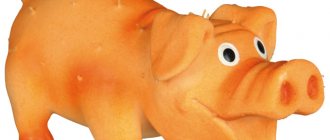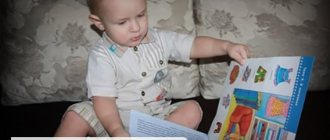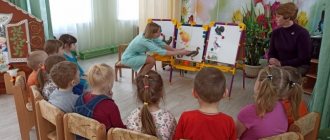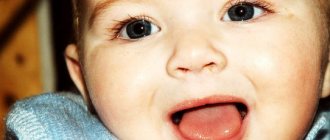Good afternoon, dear readers! When our baby was born, we witnessed her new achievements with great interest. Most of all there was the anticipation of the first words!
But, did you know that it is recommended to develop sound pronunciation skills from the very cradle? Great work. But he's worth it.
What activities are the most effective? I scoured the entire Internet in search of an answer, now I hasten to share with you.
Where to begin
A baby celebrates its birthday up to 12 times before it is one year old. After all, every month is a real holiday for parents! It's about the achievements of the little creature. In the first year of life, a little person learns a lot. Our duty, of course, is to help according to all the rules. The main thing is to organize exercises in a playful way. Well, you understand that the child needs to be interested!
From the age of two months we massaged our fingers. They just warmed up one by one. A little later, such gymnastics can be diluted with jokes and funny conversations.
And from the age of 8 months, I actively commented on what was happening to the baby. Especially on a walk. She simply and naturally talked about trees, giving characteristics regarding height, color of leaves, etc. Animals, which can be seen in large numbers on the street, have a very beneficial effect. And at 8 months I heard the long-awaited “Kh”, which in our alien language meant “cat”. Talk about everything! This is how verbal memory develops and preparation for pronouncing the first words occurs.
Home games for speech development
Speech therapy classes for children - targeted communication with the baby in a playful way.
All existing speech development exercises can be divided into 4 groups:
- finger games;
- articulation gymnastics;
- onomatopoeia and logorhythmics;
- games to expand a child's vocabulary.
Let's look at each category of exercises separately.
Finger games for speech development
Some of the most effective activities for speech development are exercises that involve the use of fine motor skills, since there is a close connection between the human limbs and the brain center responsible for pronunciation. In addition, such games are suitable for children with just developing speech, for example, at the age of 1 year.
Your child will definitely enjoy the following exercises:
- "Flower". In the initial position, form a bud from closed palms, fingers should be raised up, and wrists should be pressed tightly. After the plant blooms, the fingers spread in opposite directions. While doing the exercise, say: “The sun wakes up - the bud opens. The sun is tired - the flower is going to bed.”
- "Kitty." Algorithm of actions for speech development exercises: clench your fists and place them on the surface directly in front of you. Afterwards, you need to simultaneously open your palms and press them firmly to the table. During the process you need to say: “Fist - palm. I stomp like a cat." Repeat 3-5 times, varying the pace.
- "Hedgehog". The child will definitely enjoy this exercise. In the starting position, place your palms at a slight angle and interlace the fingers of both hands. In the process, move your fingers evenly and say: “Tiny cheerful hedgehog. How good are you?
- "The Bird and the Water" Children 5 years old are crazy about this exercise. Initially, you need to place your elbow on the table, raise your forearm and fold your fingers in a “pinch” - this will be a “beak”. When completing the task, lower your “beak” (elbow motionless) and touch the table. In the process, imitate the movements of the bird: take water, straighten your neck, swallow. Accompany the exercise with a tongue twister: “Bent over, picked up, picked up and swallowed.”
- "Chicks in the nest." Gather the fingers of your left hand into a “bunch” - these will be “chicks”. Make a ring with the fingers of your right hand - this will be a “nest”. Send the birds to the nest, taking turns changing hand positions. Add text accompaniment: “Here are the chicks, and here is the nest. The chicks are warm inside.”
Finger gymnastics with learning texts at home is an excellent alternative to regular visits to a speech therapist. Such games provoke the development of speech, teach the use of spatial imagination and develop reaction speed. After a short time, you will notice that the baby begins to remember texts better and speak more expressively.
Features of speech therapy at 2 - 3 years
If up to the age of one year the parents did not require any special knowledge of the child’s speech abilities, then by the age of two the task becomes more complicated. Speech therapy classes for children 2 - 3 years old are necessary for timely assistance in overcoming the verbal barrier. Unfortunately, not all children complete the new level in a timely manner. Children with speech impairments definitely need a competent specialist and support from their family. I will highlight the main points.
- The tasks are based on reproducing an adult’s movements, gestures, and subsequently sound pronunciation.
At such a tender age, it is impossible to verbally explain to a child what they want from him. But kids love to repeat. So play with them a fun game involving gesturing. An example would be “Magpie - magpie”, “Goat - horned”. First, show slowly, play, then ask to repeat.
- Carry out any educational processes in a playful way.
After all, this is exactly what curious researchers need. So you will be interested. But remember that children cannot pay attention to one activity for more than 20 minutes. Be able to quickly redirect your tomboy's attention.
- Make emotional contact.
Show genuine interest in spending time together. The tiny creature is extremely vulnerable and senses any notes in the adult’s change of mood. The more you are involved in the essence of the task, the happier the baby will be.
- What about the awards?
Don't forget to reward efforts. This will cause additional motivation and create a favorable background in communication. It so happened that our child learned about candy only at the age of 3. And I conducted active training for speech development with her at 2.5. She encouraged her with her favorite toys, and fruit purees replaced sweets. What I mean is that there is no need to overdo it with awards! Remember about the unstable digestive tract of the toddler.
Reasons for violations
Children who cannot speak or have a limited vocabulary should cause concern for parents. It is necessary to show the baby to a neurologist, speech therapist, dentist, or orthodontist to determine the causes of silence or developmental delay.
A stimulating factor for a decrease in speech activity or its absence can be:
- An unfavorable speech environment when parents do not communicate with the baby, spend little time together, and do not read fairy tales and poems.
- Social environment, if parents have speech impairments, the child reluctantly adopts the style of speaking, copies adults, which develops into a habit that is difficult to get rid of with age.
- Problems from the field of neurology.
- Mental retardation, intellectual impairment.
- Problems with the organs of articulation (long tongue, high palate, malocclusion, frenulum defects).
Developing general imitation
In the earliest stages of growth, children can play games aimed at reproduction. This is copying the movements of an adult, which help to relax. The tasks train coordination and imagination. Today the little one repeats gestures, and tomorrow - words. Yes, do not forget to accompany such gestures with conversations. When you have a child with general speech underdevelopment (GSD), carrying out activities of this kind is the basis of speech therapy.
The simplest thing we can offer is regular charging. Activity lovers will appreciate this. Just do the gymnastics in a strictly defined sequence. The goal here is for a tiny person to memorize the whole combination. Be sure to comment every time. Children love repetitions. And if you touch on in-depth material, you can use the following fun.
Games with general imitation
And if we talk about in-depth material, then from all the variety of exercises I have highlighted the main ones. My little girl loved these.
- "Birds"
The easiest imitator. The arms must be folded like wings and flapped like a bird. And then go for a run. Any tomboy will be delighted with such fun. Especially when an adult is involved in what is happening! Support your tomboy!
- “Putting the doll to sleep”
In our childhood it was called “Daughters - Mothers”. Give the baby a doll, arrange a sleeping place, a blanket. Ask your assistant to rock this baby to sleep. And when he puts him down, show a sign of silence: bring your index finger to your lips, saying “chi-chi-chi.” Let the baby ask the other dolls to be silent while the baby doll sleeps. If the tiny person already talks a little, explain that this needs to be done in a whisper. In the same manner, you can bathe, dress, and feed your favorite toy.
- "Poetic actions"
You can complicate the task with poetic texts using gestures. Our little one loved the rhyme “The wind blows in our faces.”
The wind is blowing in our faces, (we wave our palms in front of our faces) The tree is swaying! (handles up, tilt left and right) The breeze is getting quieter, quieter, (handles down) The tree is getting higher, higher! (Handles up, jump).
Speech imitation
Now we move on to the next stage, we try to evoke any manifestation of sound pronunciation in the child. The simplest ones, from the mooing of animals to the sounds of transport. That's why it's so important to stop at ordinary moments when walking on the street. Just don’t lisp: “Oh, who woke up?” The baby is not yet familiar with speech at all! He will imitate, but the incorrect perception of words will remain for a long time. Speak correctly if possible, of course. Control yourself in communication.
Well, in order to catch the first “sound signals” from the heir, start with something simple. This includes playing with dolls. Well, then use your imagination! Getting to know any objects that make sounds: vacuum cleaner, refrigerator. You know, my sister specifically showed her son things that required him to pronounce complex letters: “drr, brrr.” But the result is obvious! No pronunciation defects in the future.
Games with speech imitation
You can find a lot of interesting nursery rhymes on the Internet. And I’ll tell you our favorites that we enjoyed doing at home.
- "Dudochka"
Ask the little one to play the pipe. You can buy it in a store, or you can improvise. Be sure to demonstrate how the instrument sounds by saying “doo-doo.” Now it's the little musician's turn. In general, what concerns musical instruments should please the restless person. This is both a drum and a piano.
- "Let's go by car"
Place the baby on your lap, facing you. Start the car, imitating the corresponding sound. You can give an improvised steering wheel. And go! Signal: “bi-bi”!
- "Fun Zoo"
Any restless person will have toy animals in their arsenal. Collect them in a bunch and demonstrate who says what. You can, of course, do this using book pictures as an example, but toy characters are perceived better.
The role of the book
The book serves as an integral attribute in the formation of sound pronunciation. Judge for yourself, the plot, illustrations, and new characters are of interest. Perfectly suitable for use even with varying degrees of severity of OHP. The simplest texts of folk tales are aimed at helping the little one.
Sukhomlinsky also noted:
“Reading books is the path along which a skillful, intelligent, thinking teacher finds the way to a child’s heart.”
You talk, show pictures at the same time, discuss the plot. Start reading when your heir is not talking yet. Believe me, the vocabulary is already being formed. Just read with intonation so that the tomboy wants to reproduce it. Use the easiest nursery rhymes in the initial stages.
Include imitation here. You can assign roles once the script is memorized. Copy a clumsy bear, a bunny, a fox, and the baby will happily copy! Answer questions. Only when the little sly one is already able to pronounce words out loud, but uses gestures to ask for something, do not indulge.
My daughter was one of the first to master the “give” request, before she was a year old. But when I realized that I would still get the item I was interested in, I excluded it from my vocabulary. Don't be lazy! But you can’t demand either. It is important to generate interest.
Home activities
You can improve your speech abilities without leaving your home. But only if there are no serious deviations. For this, different techniques are used, which will be described below. But to replenish your child’s vocabulary and develop mental functionality, you can do the following:
- The baby must independently complete the sentences that the mother comes up with. For example, invite him to finish the following phrases: “eyes see, ears – ... (hear)”, “a Christmas tree grows in the forest, potatoes - in ... (garden).”
- An exercise that will greatly interest your child is to complete the phrase at his own request. For example: “I want to eat... (apple)”, “I can... (dance)”, “I will... (draw)”.
- It is interesting to describe objects: a rose is red, a pencil is new, clouds are white, water is transparent, felt-tip pens are multi-colored, etc.
- Show your child pictures of animals and ask them to name them, but pronounce the words clearly.
- An exercise to transform an ordinary word into an affectionate word: table - table, apple - apple, elephant - elephant, dog - dog.
- It is useful to teach your child to translate a noun into an adjective. To do this, you can use a regular ball game. Mom throws the ball and pronounces any noun (“house”, “winter”), the baby must transform it into “home”, “winter”. Any words can be chosen.
- In order for your child to learn to defend his own opinion and express his thoughts, you can play “Agreement-Disagreement.” You claim that in an hour it will be night (in fact, it will only be morning). The kid must refute this phrase, justifying it: “no, in an hour it will be day, because it’s morning.”
- Formation of new words - the child must come up with a new word by replacing just one letter. For example: cat - whale, catfish - himself, puddle - magnifying glass.
Finger games
Fine motor skills play a huge role in the development of speech, since the elements of the fingers and speech functions are directly interconnected, sending corresponding signals to the centers of the brain.
Read more about the benefits of developing fine motor skills here.
Therefore, finger gymnastics is part of speech therapy classes. It will improve speech, speed up reactions, learn to express opinions, think and concentrate.
The most effective games:
- "The white-sided magpie." It is necessary to recite the rhyme and at the same time ask the child to perform actions. Together with his mother, the baby says: “The white-sided magpie cooked porridge and fed the children.” You need to move your index finger in a circle across your palm. Next, we bend one finger at a time and say: “I gave this one in a spoon (little finger), I gave this one in a ladle (nameless finger), I gave this one in a pot (middle finger), I gave this one an inch (index finger).” Now take your thumb by the tip and shake it slightly, saying: “And you, Pakhomochek, my little kitten, heat the stove and feed the children.”
- Place your palms together, pointing your fingers upward and pressing them tightly together. The kid says the phrase: “The sun rises, the flower opens (at the same time, the fingers spread to the sides, the palms remain clenched).” After this, the child says: “The sun is setting, the flower is going to bed (return the fingers to their original position).”
- Lightly clench your palms into a fist and place them on the table surface. The kid says: “Fist and palm, and I walk like a cat.” In this case, you need, without lifting your palms from the table, unclench your fingers, stretching them forward, and clench them into a fist again.
- Cross your outstretched arms with your palms in front of you at chest level so that your two thumbs are clasped together. This will give the appearance of a bird with its wings spread. Next, make movements reminiscent of the wingspan, saying: “The bird has flown.” Next, fold your hands into fists, without releasing your thumbs, and say: “I sat down, sat and flew again” (start swinging movements again).
Articulation gymnastics
Articulation warm-up is a specialized set of exercises that are aimed at strengthening the muscular system of the articulatory apparatus.
How to conduct articulatory gymnastics for children and why it is needed in general - you will learn from this article.
It is recommended to take it before general classes. This muscle is responsible for the ability to pronounce sounds correctly. The maximum duration of the complex is 7 minutes. Classes are held in front of a mirror, the baby takes a comfortable position:
- Stretch a smile with your mouth closed. Hold for half a minute. Return to starting position.
- Smile widely with exposed teeth. Also freeze for 30 seconds.
- Open your mouth slightly and stick your tongue out onto your lower lip. Make slapping movements on both lips, pronouncing the sound “five”.
- Open your mouth, make a tube with your tongue, stretching it forward as much as possible. Hold for a few seconds.
- Make clockwise movements with your tongue along the outside of your lips. Then do the same counterclockwise. The pace is slow.
- As in the previous exercise, move your tongue in a circle, but along the inside of the teeth.
- Smile as widely as possible, opening your mouth. Pull your tongue forward and quickly move it from one corner of your lips to the other.
- In the same position, move your tongue along the upper and lower teeth.
- Open your mouth, put out and hide your tongue. The pace is fast.
- Place your tongue on your lower lip and squeeze out air. To interest your baby, you can blow on a feather or cotton wool.
You can clearly see exercises for the articular apparatus in the presented video:
Logorhythmics
Logorhythmic exercises combine gestures, pronunciation of words and musical accompaniment. They are ideal for children and adults. It is advisable to use poetic speech, which should coincide with the rhythm of the music. In this case, the child must reproduce everything that is described in the verse. For example:
- along a narrow path (the person begins to walk slightly);
- these legs walked (the pace accelerates, the knees rise higher);
- but the pebbles were in the way (the feet were trampling in one place);
- and bang straight into the pit (you need to jump and sit on the floor).
Thus, you can dramatize absolutely any poem and even a fairy tale.
Onomatopoeia
When a person tries to reproduce sounds, he not only learns to do it correctly, but begins to distinguish between them and understand the meaning. What you can do:
- Take musical instruments, a rattle, spoons, etc. Play each of them separately, asking the child to remember the sounds. Then turn the baby’s back so that he does not see what instrument is being played, and play the sounds again. Thanks to this exercise, a person learns to distinguish sounds.
- Take something that rings (a bell, a rattle, etc.) Place the baby against the wall with his eyes closed. An adult walks around the room, making ringing noises, and the child points his finger in the direction where the sounds are coming from. The exercise develops attentiveness.
- Find animal voices, let a person listen to one of them and ask them to play the sound.
- If the child is very small, you can use pictures from fairy tales and rhymes. At the same time, independently create simple sounds, for example, cats, dogs, mosquitoes, beetles.
Poems, songs, tongue twisters
Tongue twisters, rhymes, fairy tales and songs help to cope with speech defects. But you need to pronounce them at a slow pace, as this is what will allow you to pronounce the words more clearly.
It is known that a person’s vocabulary can be passive and active. The first dictionary means words that are understood, the second - words that are pronounced. But there is also a vocabulary that is inaccessible to understanding. To learn and understand new phrases, poems, fairy tales and songs are also used. Only in this case it is necessary to explain their meaning to the child.
Tongue twisters deserve special attention, as they allow you to develop diction and develop your ear for speech. There are many of them, and below are some examples:
- Sound "l":
- Polkan pushed the stick with his paw;
- Mila's mother washed her with soap, Mila did not like soap;
- in the winter cold everyone is young;
- The woodpecker was chiseling an oak tree, but didn’t finish it;
- the cat rolled the ball of thread into the corner;
- The cat lapped up the milk, and Lesha dipped a roll in the milk.
- Sounds “s” and “sh”:
- Sasha knocked off some bumps with his hat and got a bruise on his forehead;
- six little mice rustle in the reeds;
- Sasha was given porridge, and Klasha was given yogurt;
- Sasha walked along the highway and sucked on a dryer;
- the cuckoo bought a hood, the cuckoo put on the hood, he looks funny in a hood;
- Sasha loves sushi, and Sonya loves cheesecakes.
- Sound "r":
- three trumpeters sound their trumpets;
- Kondrat's jacket is a little short;
- in the meadow under the hill lies a cheese with a red crust; forty-forty ate the cheese in a short time;
- the beavers go into the pine forests, the beavers are good, the beavers are good;
- to the city the road is uphill, from the city - down the mountain;
- fish in the hole are a dime a dozen.
- Sound "z":
- The bunny has a toothache;
- The wolf saw the goat and forgot about the thunderstorm;
- On a winter morning, the birch trees ring from the frost at dawn;
- Zoya's bunny's name is Zaznayka;
- Zina was carrying a kid, a goat and a goat on a cart;
- Zoya is a know-nothing, and Zina is a know-it-all.
Exercises for clarity of pronunciation
To practice clarity of pronunciation and identify defects, it is necessary to pronounce the following words as clearly as possible:
- firewood;
- grass;
- squirrel;
- arrow;
- carrot;
- nail;
- bed;
- cancer;
- goat;
- mug;
- eyebrow;
- pianist;
- fire;
- fly;
- jump;
- write.
It is necessary to pronounce words in front of a mirror, controlling emotions and intonation, the position of the lips, tongue, and jaw. Particular attention is paid to clarity.
Breathing exercises
Breathing exercises strengthen the muscles of the oral cavity, saturate speech with emotions, and teach intonation control. The training may consist of the following exercises depending on the age category:
- When you read fairy tales, poems or turn on the sound of the wind, be sure to start blowing on the child, and let him repeat the movements after you.
- Buy a toy with blades (mill, helicopter, etc.). Ask your baby to inflate them.
- Light a candle. Let the child slowly blow it out, tilting the flame in one direction or the other. Then, with a sharp exhalation, the fire will be completely extinguished.
- Take a feather or a piece of cotton wool, which must first be fluffed. Place it on the child's hand and ask him to blow. At the same time, tell us about how this fluff floats in the air.
- You can imitate a dog's breathing. Invite your child to demonstrate the breathing of an animal at a time when he is out of breath or feels hot. Then recreate calm breathing.
- Pour hot tea into a cup and ask your child to cool it with his breath.
- Imagine that your hands are frozen - you need to warm them with the same breath.
- Blow up balloons.
- Launch a paper boat through the water, directing a stream of air at it.
- Pick a dandelion and blow it up.
- It is useful to smell flowers, which will teach the child how to separate breathing through the mouth and nose.
Book material for classes
Personally, I would recommend reading our classic A.S. Pushkin. It is impossible not to note the colorful palette of these works. How harmoniously the selection of words and phraseological units is used. It is not without reason that adults who want to correct their pronunciation are also advised to read it. It’s easier to formulate this in the initial stages than to correct it later. And besides, this is our language! And who better than the classics could present “the great and mighty” in such colors?
The role of folklore is undeniable. This will also be interesting in the very early stages. But there are children with certain problems or prerequisites. There are specially designed manuals for such people.
- “Development of vocabulary: textbook”, author Plotnikova S.V. Here we describe the features of the baby's vocabulary at each stage of life. And a set of exercises is given for each problem separately. The publication is aimed at helping the little one with the correct pronunciation.
- “Album on speech development”, author V. Volodin. Simple manipulations help the little one develop clear diction. Recommended: 3 to 5 years. This is a very important stage at which the active formation of the speaking apparatus occurs. At 3 years old, a fidget is able to repeat a lot of words. But how he will do this is another question. I have a “Large Album on Speech Development,” which contains 3 books for children (the smallest, 3-6 years old and preschoolers). In short, I'm delighted with it.
- “How to turn a “non-speaking” child into a talker”, authors T.V. Bashinskaya, T.V. Pyatnitsa. This book systematizes practical skills aimed at helping non-speaking babies. The method of participation of fine motor skills in the formation of sound pronunciation is very clearly described.
- “Speech therapy manual for classes with children”, author Bogomolova A.I. The publication contains techniques for restoring damaged sounds. What is unusual here is that the methodology is based on the works of famous authors. Everyone read Agnia Barto, S. Ya Marshak and others in childhood.
- “Speech therapist lessons. Games for speech development." Author Elena Kosinova. I really like this book. It has a huge number of finger games, articulation exercises and lots of tongue twisters.
If you are interested in what other benefits are available, I invite you here.
When to contact a speech therapist?
Each child is unique, so language development may vary slightly. Usually by the age of 5 the child already knows how to:
- Pronounce all existing sounds. An exception may be hissing ones, rarely “L”.
- Make sentences of 5-7 words.
- Understand the difference between singular and plural.
- Describe things indicating their main qualities and characteristics.
- Conduct a dialogue with peers and adults.
- Quickly say your first, last and patronymic names and your age.
If a 5-year-old child does not know how to do something from the list, it will be useful for him to attend several speech therapist lessons.
Speech therapy classes for children are aimed at increasing vocabulary, developing fine motor skills and proper breathing, and correcting sound pronunciation defects.
It is worth saying that you should not immediately take your child to a speech therapist. Children develop better at home. Here they feel more comfortable.
Impact of fine motor skills
There is probably no person who has not heard about the influence of motor skills on the brain. The mechanism is simple, an impulse is given, the brain works. With children this should be done in a playful way. It is necessary to pull something out, assemble a large mosaic, etc.
I will tell you the most accessible techniques that I used for my daughter at 1.8 years old.
- Find what's at the bottom
Take 2 bowls, pour beans into one and buckwheat into the other. And we hide small souvenirs at the bottom. Let the fidget rummage and search with both hands!
- Find identical bags
We will need 9 bags. We put the same things in every 3. I used crumpled paper, cotton wool, rice. And the cub is looking for bags that feel the same.
- Cheerful Hedgehog
Take a piece of cardboard and cut out the profile of the hedgehog. We put clothespins on top, which the restless person must remove. Learn to take it off first and then put it back on.
- Knead the dough!
Every mother has baked pies at least once. Make this a habit once a week, feed your family and benefit your kids! And the secret is that your activist helps you knead with little hands. We are still sculpting!
- Little is a lot
Use toys to explain concepts, where there are few objects, where there are many. What does big mean and what does small mean?
- Coloring pages
You can't do without pencils, paints and plasticine. There is a selection of inexpensive books where you can put circles, stickers, and decorate objects, for example, a ball. Fantasy and motor skills develop. And also show, by drawing, the concepts of long - short, sort out colors, study numbers and letters.
Exercises for general speech development at home
At home, it is imperative to regularly conduct speech therapy classes for children 4-5 years old, the exercises of which include not only the speech part, but also gymnastics for the speech organs and fingers.
Finger gymnastics
This set of simple exercises stimulates the part in the brain center that is responsible for correct speech. This is why fine motor skills classes are needed not only for the little ones, but also for preschoolers.
Finger exercises stimulate the part of the brain responsible for correct speech
All exercises are done 8-10 repetitions:
- “Opening” and “closing” the fingers on each hand. First one by one, then together. You can gradually increase the speed.
- Place your hands on the table: the left one touches the table with the palm, the right one with the back. Then at the same time you need to turn your hands over.
- First, draw a river: fold your hands, palms up, as if you have water in them. Then depict a steamboat - put your palms together, press your thumbs together and lift them up. Then depict the fish that have arrived: press all your fingers together, palms together and make movements with your hands, as if a fish is swimming.
- Draw a tree with branches - arms vertically, fingers spread out in different directions. Then show the roots of the tree - in the same position, move your hands with your fingers down. Then show leaf fall: quickly, quickly clench and unclench your fingers.
Articulation gymnastics
These exercises are aimed at developing the tongue, the main organ responsible for the correct pronunciation of sounds.
Speech development of children 4-5 years old in the middle group of kindergarten by topic
Note! Thanks to regular training in articulation gymnastics, the child will soon begin to pronounce even the most difficult sounds.
- Smile as wide as possible, teeth are closed, exactly on top of each other. Stay in this position and count 10 seconds.
- Pull your lips forward and pretend as if an elephant is drawing water with its trunk. Stay for 10 seconds in this position.
- Pretend to be a snake: smile broadly, stick out your tongue like a tube, then hide it back.
- Open your mouth wide and make a clicking sound with your tongue, imitating a horse. At the same time, it is important to ensure that the child’s lower jaw is motionless and only the tongue is working.
- Smile widely, stick out your tongue as far as possible and lightly squeeze it between your teeth. In this position, “pull” the tongue back into the mouth.
- Open your mouth wide, stick out your tongue and pretend to be a clock - move your tongue from one corner of your mouth to the other.
Repeat all these exercises 8-10 times or for 10-15 seconds.
Games for developing phonemic sound
Speech therapy games for 4-5 year old children to develop phonemic sound must be included in daily classes. They are simple and at the same time interesting, and the results will not take long to arrive. After just a month of regular exercises, the quality of children's speech will noticeably improve.
- "Game of Silence" This game is very simple. The child is asked not to make a sound for 2 minutes and close his eyes. As soon as the time is up, then ask the baby to tell what sounds he heard.
- "Clap-stomp." The essence of the game: agree in advance with the child which sound he will stomp on and which sound he will clap on. For example, if he hears the sound [w], then he stomps his foot, if the sound [r], then he claps his palms. Next, the adult names different sounds, and when the child hears the ones he needs, he claps or stomps.
- "Catch the word." The essence of this game is simple: the child is given a word, upon hearing which he will have to clap his hands. Next, the adult names several words in turn that sound similar. As soon as the child hears what he needs, he should clap his hands.
To develop phonemic sound, it is necessary to regularly play speech therapy games
Sensory development
A necessary event for children. Helps to distinguish objects from each other through vision, touch, taste, and smell. Distinguish among themselves: large - small, long - short, thin - thick, narrow - wide, salty - sweet. In addition, studying colors. The most basic: red, blue, green, yellow.
It is very good to learn such things while walking. Examples include trees, sticks of different lengths, and grass. You can draw on the asphalt with chalk, making sure to let your heir try this innovation. Well, in apartment conditions, the sensory technique is used on the basis of special pictures. You can cut out cardboard strips with the desired characteristics and draw. Just look at household items.
Games with water, with various materials, cereals and dough in the article “Sensory development”
Fun workout
Many textbooks for speech therapy recommend the use of articulatory gymnastics. Its essence is in training the muscles of the tongue, lips, cheeks. Our daughter really liked these manipulations. The peculiarity of charging is that the actions are performed slowly. The necessary muscles must be tense.
Exercises for the tongue
- Swings. Sticking out your tongue, try to reach your nose, then your chin.
- Spiral. Turn your tongue now to the right, now to the left, making movements in a circle.
- Let's ride a horse. We depict the clopping of a horse. We didn’t succeed right away, but when the lesson was mastered, there was no limit to our joy!
- Who's come? The tomboy sticks out his tongue, repeating after the adult who comments:
The tongue looked out the window to see who came to visit him (they stuck out their tongue). But I didn’t find anyone there, I looked to the left (they turned their tongue to the left). I looked to the right, up, down (we repeat the movements in the corresponding directions).
The advantage of such techniques is that children do not need to be forced, they themselves ask to work out!
Kneading your cheeks and lips
- Inflating the samovar
Puff out your cheeks, then slowly release the air. You can roll air from one half of the mouth to the other.
- We are silent like a fish
We depict a fish mouth, pulling in the cheeks and pulling the lips forward. But this is not the limit; you need to work with your lips. A very funny trick.
The lips themselves can be trained by pronouncing the simplest sounds, stretching them into a tube, etc. And also develop breathing, this helps to pronounce words. You can blow pieces of paper or cotton wool onto a sliding surface.
How to conduct classes at home correctly
It is not necessary to immediately run to a speech therapist. To begin with, you can try exercises for speech therapy classes for children 4-5 years old at home. They will help the child master correct speech, learn to hear and pronounce missing sounds.
Children should definitely be taught at home so that they learn how to pronounce sounds correctly.
Typically, speech therapists advise following these simple rules:
- Exercises should be performed every day, always in a child-friendly environment.
- Be sure to conduct lessons in a playful way. It is important to captivate the child so that the tasks do not seem boring and uninteresting to him. You can even arrange a sort of competition to see who can complete the tasks better or faster.
- You cannot criticize or make sarcastic remarks to your child. So the desire to learn something new will disappear completely. Be sure to praise your child when he completes a task. Even if something doesn’t work out, you need to praise him for trying.
- For classes, be sure to use literature that is designed to help parents teach their children independently. There are special reference books on speech therapy, which contain many different exercises for children, as well as recommendations for parents.
- A speech therapy exercise for children 4-5 years old can be turned into pleasure if you correct your speech by studying rhymes and tongue twisters. They will not only allow the child to quickly grasp the necessary sounds, but will also have a positive effect on the development of memory.
- You need to show your child an example of correct speech. Pronounce all words clearly so that the baby understands and clearly hears what is being said to him. You need to talk to him as much as possible, have conversations on any topic, tell different stories.
Didactic games on speech development for the preparatory group
High-quality warm-up for lips and tongue
Warming up the lips and tongue plays an important role in the formation of correct speech.
Note! The baby will begin to pronounce words more clearly, without swallowing the ending.
Exercises as a warm-up:
- Stretch your lips in a smile without showing your teeth. You should try to smile as widely as possible.
- Pull your lips forward as if they were an elephant’s proboscis.
- Take turns inflating one or the other cheek, then retract them in the same order.
- Open your mouth and pull your lower jaw as low as possible, while holding your tongue to the roof of your mouth.
- Open your mouth, stick out your tongue. Then put it in your mouth. Do this exercise for 15 seconds.
- Pull out your tongue and blow on a piece of cotton wool on the table until it falls off the table. Blowing with lips is prohibited.
- Use the tip of your tongue to first move along the upper teeth from the inside, then along the lower ones.
- “Scratch” your tongue with your teeth, resting on the lower gum.
Important! To achieve visible results, you need to perform these exercises regularly. Each of them must be repeated at least 5-6 times.
Articulation gymnastics for stuttering
The problem of stuttering is identified in the early stages, when the little one begins to speak. For now, the problem can be corrected with special training. These include articulatory exercises using facial expressions. Here we exercise the forehead, mouth, tongue, eyes.
- We tense our eyebrows and get angry. Then we relax, a sign of surprise.
- Wink your eyes, close your eyes.
- We chew with the sound “woah”.
- We pretend to rinse our mouths, gargle.
- We smile, stretching our mouth.
- We show the upper and lower teeth.
- We brush our teeth, but not with a brush, but with a tongue from the inside and outside.
And we turn on our imagination, depicting the faces of various characters. You can be angry or happy, whine or laugh. Children with stuttering can and should be helped at home by performing a daily course of special procedures. Remember that it’s easier with little ones than with older brats. At the age of 2 - 3 years, our restless children perceive such important tasks as fun. Therefore, 2 functions are combined at once.










